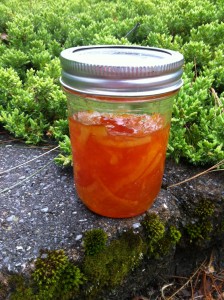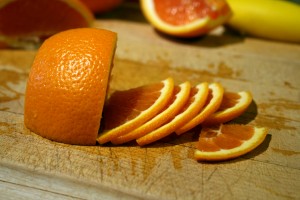It’s getting closer to that time when I get to start canning and making jams, jellys, and preserves again. I’m sure we all remember the yummy strawberry and carrot cake jams of last year. The Nerdly Home is in the process of moving, and we’ll be near a very large weekly farmers’ market, ensuring that I’ll soon be posting lots of pictures of my spreadable triumphs.
Lest I get too full of myself, I feel I must relate the tale of The Orange Marmalade Disaster.
That’s some pretty looking marmalade, isn’t it? Looks good enough to spread on a warm crumpet or maybe even a scone. It looks so refined, so elegant.
Well, it tastes awful.
I’m not sure why I wanted to make marmalade. I think it had a lot to do with the fact that it was winter, and one of the few things in season and actually worth canning was citrus. When cruising around looking for recipes, I found one from Alton Brown. Not only was it simple, it was from someone whose recipes I trust. I read through the recipe reviews and learned that I’d probably have to cook it longer than the recipe called for, but otherwise, they were all positive. I felt confident in the recipe and felt well prepared.
I went to the store and bought the best looking oranges I could find. I brought them home and lovingly sliced them by hand. I enjoy using these sorts of opportunities to sharpen my knife skills.
This is the point where we encounter the problem with Alton Brown’s recipe. No where does it tell you what variety of oranges to use. More importantly, it doesn’t tell you what varieties not to use.
It turns out that navel oranges, the ones that were newly in season and the best looking at the store, have way too much pith (the bitter white stuff) to use in marmalade. Well, you can use them, but you have to peel them, then remove the pith from the peel before adding the peel back into the mix. Juicing type oranges like valencias are much better, since they have a thinner layer of pith. The pith, while bitter, does contain the pectin you need to help your marmalade stay together. It’s a magical balance that takes cooking from science to art.
So after my hours of careful cooking and canning, I wound up with eight jars of beautiful, bitter, foul tasting orange marmalade. To make matters worse, because of the excess amount of pith, I wound up with a marmalade so stiff, I’m fairly certain that I couldn’t spread it on anything if I tried. I did let the marmalade rest a few days, since some reviews and instructions said that even with the right oranges, the marmalade can be bitter immediately after it’s made and will mellow over time. This didn’t. There’s no saving it.
So in the near future, when berries and fruits go from farmers’ market to jars in my kitchen with delicious results, let’s all remember the tragedy of the orange marmalade. We’ll call it a “learning experience” and soldier on.

